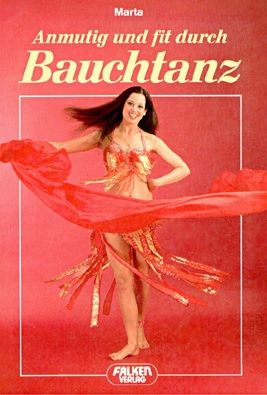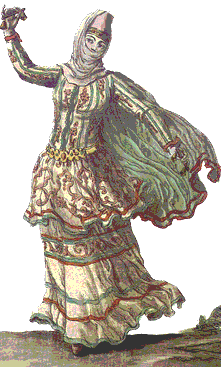All About Marta

Orientalischer Tanz
Der orientalische Tanz ist eine der wenigen Tanzformen, bei der die Betonung auf der Isolierung bestimmter Koerperteile liegt. Diese Isolationsuebungen vermitteln ein intensives Verstaendnis fuer den eigenen Koerper, da man lernt, jeden Muskel enzeln zu bewegen, und der Koerper dadurch geschmeidiger wird. Als Fitnessprogramm hat er sich sehr bewaehrt. Wenn Sie jedoch 35 Pfund loswerden moechten, versuchen Sie es besser mit einer Abmagerungskur. Mit dem Bauchtanz koennen Sie Ihre Muskeln staerken und festigen und Ihre Figur verbessern. Er verhilft Ihnen zu einem gesunden Kreislauf und trainiert die Haltung und Anmut Ihres Koerpers. In den USA wird der Bauchtanz von vielen Aerzten als Therapie bei koerperlichen und seelischen Stoerungen empfohlen.
Der aegyptische und der tuerkische Stil
Es gibt zwei verschiedene Stilrichtungen des orientalischen Tanzes: den aegyptischen und den tuerkischen Stil.
Die aegyptische Musik des Tanzes ist sehr komplex und von feiner Struktur. Sie ist reich an Rhythmus- und Stimmungswechseln. Wie die westliche Music benutzt die arabische Musik Ganz- und Halbtoene, zusaetzlich jedoch noch Vierteltoene.
Das erfordert natuerlilch auch vielfaeltige Schrittkombinationen und Bewegungen von entsprechender Praezision, Phantasie und Feinheit.
Die tuerkische Musik basiert auf eher einfacheren Rhythmen und kuerzeren, sich wiederholenden Melodien. Es werden ur Ganz und Halbtoene benutzt. Die Tanzschritte haben sich der Musik entsprechend entwickelt. Das untrainierte Auge kann der tuerkischen Tanz-form leichter folgen, sie erscheint ihm dynamisch und frei.

This section of the site is still a work in progress. The content will soon be available in German and English. Bear with me, I know there are typos :)
The Takasim
The opening music of the dance is followed by a Takasim.
A takasim is the unwritten solo of one of the instruments of the orchestra, for example, the violin, nay or kanun. The solo is very melodic and often completely improvised, directed by the mood of the soloist and the dancer - and therefore intense and emotional. It is quite possible that a show will have more than one takasim. Generally, the first takasim is played by the violinist.
The takasim can be performed with or without rhythmic accompaniment. In my shows, I prefer the first takasim without rhythm (as do most of the other Egyptian style dancers). The sudden atmospheric change from the dynamic entrance music to the sentimental part of the solo instrument adds an breath-taking effect on the audience and also on me!
The emphasis of this chapter is the demonstration of the suppleness of our bodies. We achieve that through focusing the attention to a specific body isolation. For example, the shoulder, while the rest of the body remains still or in a supporting position.

We need your consent to load the translations
We use a third-party service to translate the website content that may collect data about your activity. Please review the details in the privacy policy and accept the service to view the translations.